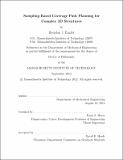| dc.contributor.advisor | Franz S. Hover. | en_US |
| dc.contributor.author | Englot, Brendan J | en_US |
| dc.contributor.other | Massachusetts Institute of Technology. Dept. of Mechanical Engineering. | en_US |
| dc.date.accessioned | 2013-03-28T18:16:54Z | |
| dc.date.available | 2013-03-28T18:16:54Z | |
| dc.date.copyright | 2012 | en_US |
| dc.date.issued | 2012 | en_US |
| dc.identifier.uri | http://hdl.handle.net/1721.1/78209 | |
| dc.description | Thesis (Ph. D.)--Massachusetts Institute of Technology, Dept. of Mechanical Engineering, 2012. | en_US |
| dc.description | This electronic version was submitted by the student author. The certified thesis is available in the Institute Archives and Special Collections. | en_US |
| dc.description | Cataloged from student-submitted PDF version of thesis. | en_US |
| dc.description | Includes bibliographical references (p. 173-186). | en_US |
| dc.description.abstract | Path planning is an essential capability for autonomous robots, and many applications impose challenging constraints alongside the standard requirement of obstacle avoidance. Coverage planning is one such task, in which a single robot must sweep its end effector over the entirety of a known workspace. For two-dimensional environments, optimal algorithms are documented and well-understood. For threedimensional structures, however, few of the available heuristics succeed over occluded regions and low-clearance areas. This thesis makes several contributions to sampling-based coverage path planning, for use on complex three-dimensional structures. First, we introduce a new algorithm for planning feasible coverage paths. It is more computationally efficient in problems of complex geometry than the well-known dual sampling method, especially when high-quality solutions are desired. Second, we present an improvement procedure that iteratively shortens and smooths a feasible coverage path; robot configurations are adjusted without violating any coverage constraints. Third, we propose a modular algorithm that allows the simple components of a structure to be covered using planar, back-and-forth sweep paths. An analysis of probabilistic completeness, the first of its kind applied to coverage planning, accompanies each of these algorithms, as well as ensemble computational results. The motivating application throughout this work has been autonomous, in-water ship hull inspection. Shafts, propellers, and control surfaces protrude from a ship hull and pose a challenging coverage problem at the stern. Deployment of a sonar-equipped underwater robot on six large vessels has led to robust operations that yield triangle mesh models of these structures; these models form the basis for planning inspections at close range. We give results from a coverage plan executed at the stern of a US Coast Guard Cutter, and results are also presented from an indoor experiment using a precision scanning laser and gantry positioning system. | en_US |
| dc.description.statementofresponsibility | by Brendan J. Englot. | en_US |
| dc.format.extent | 186 p. | en_US |
| dc.language.iso | eng | en_US |
| dc.publisher | Massachusetts Institute of Technology | en_US |
| dc.rights | M.I.T. theses are protected by
copyright. They may be viewed from this source for any purpose, but
reproduction or distribution in any format is prohibited without written
permission. See provided URL for inquiries about permission. | en_US |
| dc.rights.uri | http://dspace.mit.edu/handle/1721.1/7582 | en_US |
| dc.subject | Mechanical Engineering. | en_US |
| dc.title | Sampling-based coverage path planning for complex 3D structures | en_US |
| dc.type | Thesis | en_US |
| dc.description.degree | Ph.D. | en_US |
| dc.contributor.department | Massachusetts Institute of Technology. Department of Mechanical Engineering | |
| dc.identifier.oclc | 829699625 | en_US |
